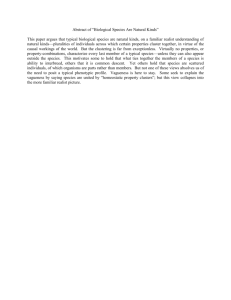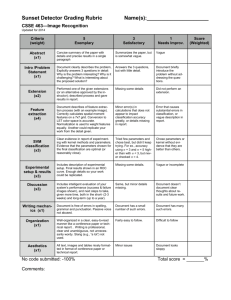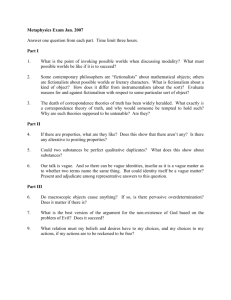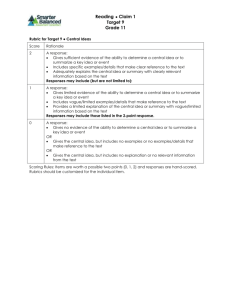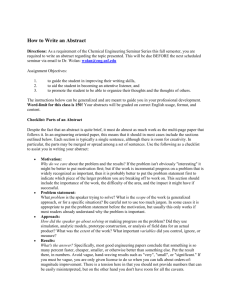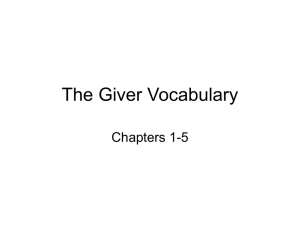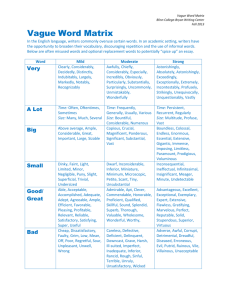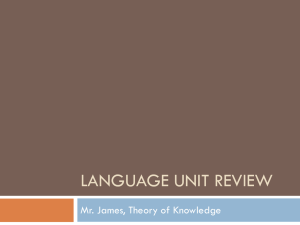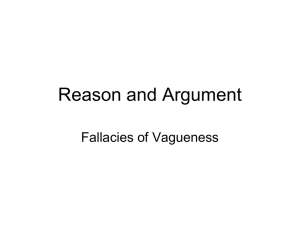Reply to Greenough
advertisement
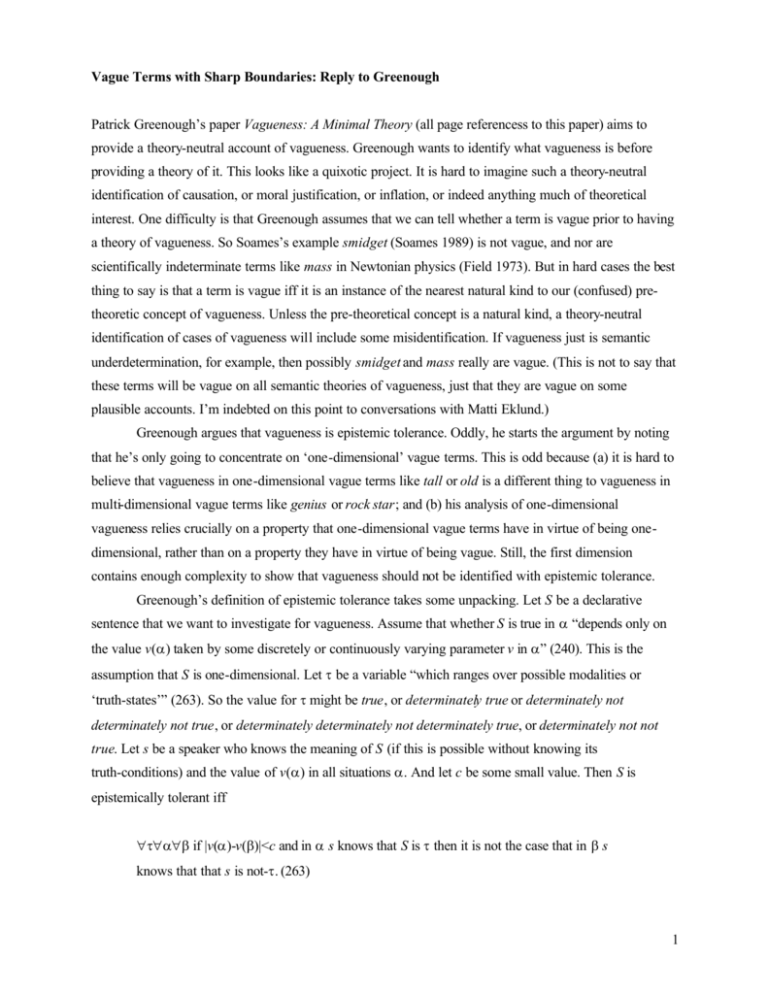
Vague Terms with Sharp Boundaries: Reply to Greenough Patrick Greenough’s paper Vagueness: A Minimal Theory (all page referencess to this paper) aims to provide a theory-neutral account of vagueness. Greenough wants to identify what vagueness is before providing a theory of it. This looks like a quixotic project. It is hard to imagine such a theory-neutral identification of causation, or moral justification, or inflation, or indeed anything much of theoretical interest. One difficulty is that Greenough assumes that we can tell whether a term is vague prior to having a theory of vagueness. So Soames’s example smidget (Soames 1989) is not vague, and nor are scientifically indeterminate terms like mass in Newtonian physics (Field 1973). But in hard cases the best thing to say is that a term is vague iff it is an instance of the nearest natural kind to our (confused) pretheoretic concept of vagueness. Unless the pre-theoretical concept is a natural kind, a theory-neutral identification of cases of vagueness will include some misidentification. If vagueness just is semantic underdetermination, for example, then possibly smidget and mass really are vague. (This is not to say that these terms will be vague on all semantic theories of vagueness, just that they are vague on some plausible accounts. I’m indebted on this point to conversations with Matti Eklund.) Greenough argues that vagueness is epistemic tolerance. Oddly, he starts the argument by noting that he’s only going to concentrate on ‘one-dimensional’ vague terms. This is odd because (a) it is hard to believe that vagueness in one-dimensional vague terms like tall or old is a different thing to vagueness in multi-dimensional vague terms like genius or rock star; and (b) his analysis of one-dimensional vagueness relies crucially on a property that one-dimensional vague terms have in virtue of being onedimensional, rather than on a property they have in virtue of being vague. Still, the first dimension contains enough complexity to show that vagueness should not be identified with epistemic tolerance. Greenough’s definition of epistemic tolerance takes some unpacking. Let S be a declarative sentence that we want to investigate for vagueness. Assume that whether S is true in α “depends only on the value v(α) taken by some discretely or continuously varying parameter v in α” (240). This is the assumption that S is one-dimensional. Let τ be a variable “which ranges over possible modalities or ‘truth-states’” (263). So the value for τ might be true, or determinately true or determinately not determinately not true, or determinately determinately not determinately true, or determinately not not true. Let s be a speaker who knows the meaning of S (if this is possible without knowing its truth-conditions) and the value of v(α) in all situations α. And let c be some small value. Then S is epistemically tolerant iff ∀τ∀α∀β if |v(α)-v(β)|<c and in α s knows that S is τ then it is not the case that in β s knows that that s is not-τ. (263) 1 I have four objections to this as account of vagueness; two of these are fairly trivial but two are serious. The first trivial objection is that this theory implies, falsely, that S is vague if all terms in S are rigid designators. So 7 is prime is vague, because in any situation α, it is true, and determinately true, and determinately determinately true, and so on, while in all situations β such that |v(α)-v(β)|<c (or that |v(α)-v(β)|=c), it is not known in β that 7 is prime is not true, or not determinately true, and so on. Presumably the theory is meant to apply to sentence radicals, like x is prime, rather than to complete sentences like 7 is prime. Indeed, all of Greenough’s examples involve such radicals (save when he is explicitly talking about predicates). So I will assume the theory to be so interpreted. The second trivial objection is that even with this restriction, we still over-generate vagueness. The sentence radical x is self-identical turns out to be vague for just the same reason. It is not immediately obvious how to avoid this problem. We could say that S is vague only if it takes different truth values for some values of x. This is certainly the most obvious response to this problem. This will rule out x is self -identical being vague, but it might rule out too much. Define a new predicate virtuous such that x is virtuous iff x is self-identical and 7 is small. (I assume 7 is a penumbral case of smallness.) Then intuit ively, x is virtuous is vague, but its truth-value is independent of x. Perhaps there is some other technical fix possible here, so I will not press the point. The first serious problem concerns predicates that are true of objects in a range, and one of the borders of the range is sharp while the other is vague. Such predicates are bound to be a little artificial, but to a good approximation early thirties, as in Shane Warne is in his early thirties, is such a predicate. I assume that one enters ones early thirties precisely on one’s thirtieth birthday, but it is a little vague when one leaves this era. (Precisely when one turns thirty is a little unclear, which complicates matters. I will assume a slightly artificial language where we precisely measure ages by how many circuits of the sun have passed since the subject’s umbilical cord was cut.) At thirty-three, as he now is, I assume Mr Warne is still in his early thirties. I would say, though some would not, that even when he turns thirty-four this September, he will still be in his early thirties. But from then on matters get a little dicey. Will he still be in his early thirties at thirty-five? At thirty-six? Thirty-seven? Thirty-eight? Probably not by then. Note that as defined, if S is x is in his early thirties, it is not epistemically tolerant. Let α be a situation where x has just turned thirty, and β a situation immediately before this happens. If s knows all the details, she knows S is true in α and not true in β. But α and β differ minimally, so S is not epistemically tolerant. But it is, intuitively, vague. I think Mr Warne will be a penumbral instance of early thirties for a while to come. If you disagree, insert some other predicate that has the feature that it is sharply bounded at one end, and vaguely bounded at another. It is implausible that there could be a conceptual restriction on languages that they not contain such a term. And such terms are vague despite being epistemically tolerant. 2 Such problems become magnified when we look at multi-dimensional vague terms. If whether or not x is F depends on a number of factors, some of them precisely specified and others vaguely specified, then x is F will be epistemically intolerant despite being vague. Greenough has a formal argument that the kind of case I have described, an epistemically intolerant term with borderline cases, is impossible. Since the argument’s conclusion entails that early thirties does not exist, it must be mistaken. Actually, once we have the example in front of us, it is not too hard to find the mistake. The argument is an attempted reductio on the hypothesis that there is a borderline case m of F even though F is epistemically intolerant. If F is intolerant, there is an x such that Fx is knowable while Fx´ is knowably false (where x´ differs minimally from x). There are a number of cases to consider depending on the ordering relation between x, x´ and m, but we will focus on just the one that matters, where x´ is 29.99 years old, x is 30.01 years old, and m is right around the end of his early thirties. The key premise is that if m is older than x, and x is knowably in his early thirties, then m is knowably in his early thirties. This is obviously false. It looks plausible in the context of the paper because the focus is on predicates like old or tall that do not change truth value twice as you move along their underlying scale. Anyone older than an old person is old. Take old to be the paradigm for F, and it might look plausible that if x´ < x < m and x´ is not F although x is, then for all y if s knows that y is F then she can know that y+1 (or someone one ‘more’ than y in the relevant dimension) is F. This is just what Greenough does assume (sentence 14 on page 271). But it is false when F is early thirties. Once we see that borderline cases and tolerance come apart for predicates that change truth value frequently as v changes, the way is open to see that tolerance really has little to do with borderline cases, and hence with vagueness. Consider the predicate of numbers is a small integer. This has borderline cases, such as 7, but it is in a sense everywhere intolerant. For every number x, either x is not an integer and we can know whether x is a small integer is τ for every τ, or x is an integer and there will be a number y arbitrarily close to x such that for some τ we know that x is a small integer is τ and y is a small integer is not τ. To see this, let τ be not determinately … determinately not true, where there are x instances of determinately. Assuming that 1 is determinately small, and that for all τ of that form if x is determinately τ then x-1 is τ, we conclude that x satisfies this ‘truth modality’, but x+ε does not, since it is not an integer. I suspect that in English only compound predicates are vague while being everywhere intolerant. So one might think that tolerance was constitutive of vagueness for simple expressions, while something else was constitutive of vagueness for compound expressions. (Even early thirties, which is intolerant at one boundary point, is structured.) But it is hard to believe either that what is constitutive of vagueness differs for simple and compound expressions, or that a theory of vagueness, let alone a minimal theory, should turn on which meanings can be assigned to unstructured predicates. The second serious problem turns on an objection to the use of any epistemic concepts in a theory of vagueness. It is contentious that typical borderline cases generate ignorance. Cian Dorr (forthcoming) 3 has argued that in borderline cases of Fness, it is just as indeterminate whether someone can know that the object is F as whether the object is, in fact, F. If this is right then even the minimal theory, which says that indeterminacy implies ignorance, goes to far. I won’t go into most of Dorr’s arguments here, partially for space reasons and partially because they aren’t my arguments. But it’s worth considering one relatively simple argument for the conclusion Dorr reaches. (A similar argument to this one appears in Hawthorne forthcoming, although there the primary issue is the nature of omniscience.) Assume that we have three demonstrations, and while it is determinate that the second and third demonstrations pick out determinately different objects, and it is determinate that the first picks out either the same as the second or the third, it is vague whether the first picks out the same object as the second or the third. For example, the first might pick out Princeton, the second Princeton Borough and the third Greater Princeton, to use an exa mple from David Lewis (1993). Or the first might pick out Theseus’s ship as it leaves port, and the second and third the two ships that return to port. (Thanks to Cian Dorr for suggesting this case, and for suggestion the use of pronouns rather than names in the following argument.) I’ll use ‘thatn ’ as a demonstrative associated with the n’the demonstration. Then the premises of this argument all look plausible, and the argument is classically valid. 1. Either that1 is that2 or that1 is that3 2. It is indeterminate whether that1 is that2 3. It is indeterminate whether that1 is that3 4. I know that that2 is that2 5. I know that that3 is that3 6. If that1 is that2 then if I know that I know that that2 is that2 then I know that that1 is that2 7. If that1 is that3 then if I know that I know that that3 is that3 then I know that that1 is that3 C. Either I know that that1 is that2 even though it is indeterminate whether that1 is that2 , or I know that that1 is that3 even though it is indeterminate whether that1 is that3 . Premises 1, 2 and 3 follow from the case description, premises 4 and 5 rely on my knowledge of basic predicate logic, and premises 6 and 7 follow from Millianism about demonstratives, which is at least a plausible theory of demonstratives. Perhaps it could be argued that this isn’t really a case of vagueness, and perhaps the Millianism about demonstratives can be rejected. This isn’t obvious though. I suspect that the argument basically is a sound argument against epistemicism about vague demonstratives. Even if that’s not obviously right, the argument tells against the use of epistemic concepts in a minimal theory of vagueness. Such a minimal theory seems to beg the question against the proponent of Dorr’s position, and that position has some theoretical support as illustrated here. Since Greenough has argued that any minimal theory of vagueness that uses non- epistemic concepts begs the question against the epistemicist, 4 we might well conclude that any minimal theory of vagueness will be question begging, and hence unsatisfactory. This should not be a depressing conclusion. As noted in the introduction, there’s no way to isolate instances of most the concepts we use in philosophy, or economics, or psychology, or biology, or linguistics, or any other special science, in a theory neutral way. But the special sciences progress anyway. Let me close on a more agreeable note. Greenough notes, correctly, that one thing a theory of vagueness must do is explain why the Sorites is so “seductive” (272). A theory of vagueness that suggests Sorites arguments bear no interesting relationship to sound philosophical reasoning will miss an important feature of their phenomenology. We are struck by the plausibility of some Sorites arguments, and a complete theory of vagueness should explain this. Two explanations have recently been receiving some attention in the literature. Contextualist solutions, as endorsed by Soames (1998) and Graff (2000) say that Sorites arguments look plausible because we can never ‘focus’, as Graff puts it, on a counterexample. The content of a vague term like small is context-relative, and one of the aspects of context that matters is how the term has been used in recent conversation. When we agree that, say, 6 is small, we shift the context so that 6 is now a determinate case of smallness, and nearby terms, like 7, must also be small. If we go on to say that 7 is small, then context will ensure it is determinately small, so 8 will be small, and so on. Although in any context there are adjacent x, y such that x is small and y is not, we can never say what they are without moving the boundaries. We think the Sorites is true because we note that whenever we say any of the premises, they are true. But this does not entail that every premise is true, any more than the fact that whenever someone says, “I’m talking.” they speak truly entails that everyone in the world is talking. Conceptualist solutions, as endorsed by Sorensen (2001) and Eklund (2002), say that it is part of our semantic competence with vague terms that we endorse the premise of Sorites arguments. Competence leads us astray here, because one of these premises is false, but there is something intuitively appealing about the idea that someone who just denied a particular Sorites premise would not have got the point of vague terms. There’s an old bit of folk wisdom in Australian politics that when faced with a choice between a conspiracy and a stuff-up, always choose the stuff-up. That’s good advice in philosophy too. Greenough suggests that something much simpler explains why the Sorites is attractive: we mistake it for something else. I don’t agree with the details of his account, but I think an explanation in terms of speaker confusion is on the right track. For one thing, this theory has relatively low overheads: it is much easier to accept that people make mistakes than that there is the amount of contextual sensitivity required by the Soames and Graff, or the kind of false meaning postulate required by Sorensen and Eklund. That’s basically the insight behind the bit of folk wisdom I started with. I’ll conclude by noting one nice advantage Greenough’s explanation (or something like it) has over its contemporary rivals. 5 Greenough starts by noting two plausible, but inconsistent, claims that could be used in a Sorites argument. (SS1) ∀α∀β if |v(β)-v(α)|<c then S is true in α iff S is true in β. (SS2) ¬∃α∃β such that |v(β)-v(α)|<c and S is true in α and ¬S is true in β. (241) Both (SS1) and (SS2) lead to inconsistencies given other plausible premises, so they must be rejected. But Greenough notes we can explain why they are plausible, or seductive, by noting that they could easily be confused for two claims (ET5) and (ET6) which he says are true. (ET5) ∀α∀β if |v(β)-v(α)|<c then it is knowable that S is true in α then it is S is true in β. (ET6) ¬∃α∃β such that |v(β)-v(α)|<c and it is knowable that S is true in α and it is knowable that ¬S is true in β. (263; these two have each been simplified a little to focus on the issue I’m interested in) I’m not entirely sure how we could confuse (SS1) for (ET5), or whether either (ET5) or (ET6) are true, but I think the general strategy is right, whatever the virtues of the details. One reason for this is that a good explanation of why (SS1) and (SS2) look so seductive should also explain why some similar claims to these are not attractive. In particular, we should explain why (SS2a) is not so attractive. (SS2a) ∀α∀β if |v(β)-v(α)|<c then either S is true in α or S is false in β. More generally, we should explain why the history of philosophy is littered both with Sorites arguments whose premises look like (SS1) or instances of it, premises involving conditionals relating similar cases, and with Sorites arguments whose premises look like (SS2) or instances of it, premises involving negated conjunctions relating similar cases, never in the history of philosophy has a Sorites argument using premises like (SS2a), premises involving disjunctions relating similar cases, has been promoted. Never, for instance, has the following argument been suggested as the foundation of a paradox. 6 1. 1 is small 2. Either 1 is not small, or 2 is small. 3. Either 2 is not small, or 3 is small. … 8. Either 7 is not small, or 8 is small. … n. Either n-1 is not small, or n is small. C. n is small. (This observation about the history of the Sorites is also made in Braun and Sider ms.) That Sorites argument is not at all powerful; we have very little incentive to accept premises like 8. And I think a theory like Greenough’s has the resources to explain this, while it’s not so clear that the contextualist or conceptualist theories do not. Note, in particular, that it is hard to find a way to turn (SS2a) into a claim like (ET6a) which is even approximately true. In particular, (ET6a) is not true. (ET6a) ∀α∀β if |v(β)-v(α)|<c then either it is knowable that S is true in α or it is knowable S is false in β. I presume the explanation of why we confuse (SS2) for (ET6) is that we systematically confuse claims about what is true for claims about what is knowable, even when they are embedded inside quantifiers and negations. If that’s right then we should confuse the false (SS2a) for the even more obviously false (ET6a). That’s why folks regularly don’t accept (SS2a), or the premises in my little Sorites argument, even when they accept (SS2). I won’t try and present a conclusive argument for this here, but I suspect there’s no way to spell out the contextualist or conceptualist explanations of why (SS2) is attractive without predicting, falsely, that (SS2a) will also be attractive. So while I don’t think that Greenough’s theory of what we mistake Sorites premises for is quite right, largely because it doesn’t work for predicates like small integer, I think it is much more promising than its prominent rivals. 1 1 Thanks to Cian Dorr and Matti Eklund for very helpful discussions about this paper. 7 References Braun, David and Theodore Sider (ms.) “Vague, So Untrue”. Dorr, Cian (forthcoming) “Vagueness without Ignorance”, forthcoming in Philosophical Perspectives. Eklund, Matti (2002) “Inconsistent Languages” Philosophy and Phenomenological Research 64: 251-75. Field, Hartry (1973) “Theory Change and Indeterminacy of Reference,” Journal of Philosophy 70: 462-81. Graff, Delia (2000) “Shifting Sands: An Interest-Relative Theory of Vagueness” Philosophical Topics 28: 45-81. Greenough, Patrick (2003) “Vagueness: A Minimal Theory” Mind 112: 235-81. Hawthorne, John (forthcoming) “Vagueness and the Mind of God” forthcoming in Philosophical Studies. Lewis, David (1993) “Many, but Almost One” in John Bacon et. al.(eds.), Ontology, Causality and Mind, pp. 23–42. New York: Cambridge. Soames, Scott, (1989) “Presupposition” in D. Gabbay and F. Guenthner, eds., Handbook of Philosophical Logic , vol. IV, pp. 553–616. Dordrecht: Kluwer. — (1998) Understanding Truth . Oxford: Oxford University Press. Sorensen, Roy (2001) Vagueness and Contradiction. Oxford: Clarendon Press. 8
